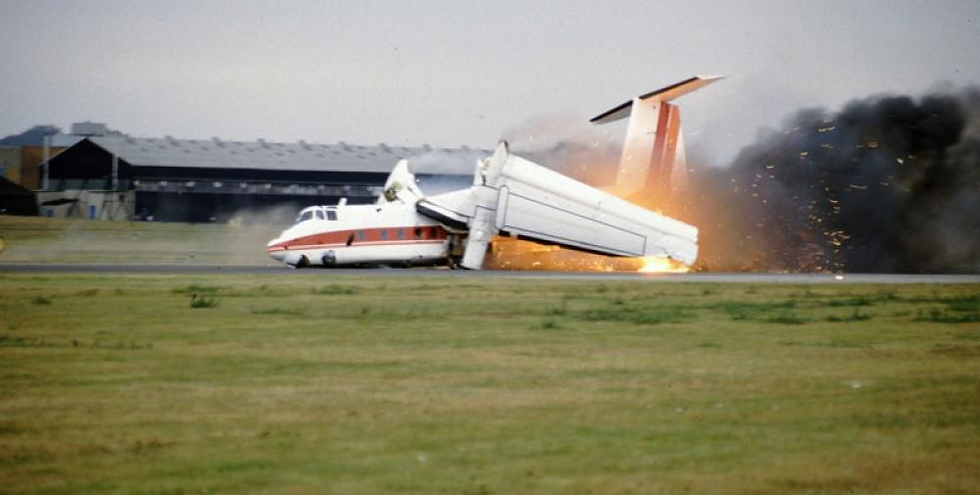4th of September 1984, Blog #527
- V2Aviation

- Sep 3, 2022
- 3 min read
A de Havilland Canada DHC-5D Buffalo was participating in the 1984 Society of British Aerospace Companies Farnborough International Air Display. Prior to the demonstration flights, all crew had attended the mandatory briefing.

The aircarft sliding down the runway shortly after the heavy landing (Source; baaa-acro.com © Unknown) The purpose of the Buffalo aircraft display was to show the aircraft's Short Take-Off and Landing (STOL) capabilities. It was planned to consist of a;
Short Field Take-Off
Fast Flypast
Tactical landing
Just before the demonstration flight, the pilots discussed the demonstration flight profile and the influence the wind would have, and which adjustments to the flight profile were necessary to maintain the necessary safety margin. Besides the pilots a company lawyer was onboard the aircraft, he was on the jump seat. After start-up clearance was received at 15.03 lt (local time) the crew completed all the necessary checks and taxied out to the runway behind a company Dash 7 and Dash 8. At 15.16 lt the brakes were released and the Buffalo commenced its take-off run behind the two company aircraft. Once airborne a steep climb to 1000 feet AGL was performed while the landing gear was retracted and the flaps raised to 10º. This was followed by descending rigth turn during which the flaps were retracted. A low flypast over the display line followed at a heigth of 250 feet AGL at a speed of 215 Knots. At the end of the flypast the aircraft entered a climbing turn for the STOL landing on runway 25. The aircraft was configured for landing as landing gear was selected down at the same time as the flaps were selected to 40º. The proppelors were set to the right piychc and the rear cargo door was opened and the ramp lowered. ATC cleared the aicraft to land, providing them with the latest wind report (northerly wind at 12 knots).

Aircraft recovery in progress (source; www.aviadejavu.ru © Unknwown)
The aircraft headed towards the runway in a sideslipping descending righthand turn. Just before touchdown the aircraft was flown back on to the centre line of the runway, and the bank angle and descent rate were reduced. As the aircraft crossed the thresholf the captian became aware of an excesive rate of descent and added engine power in an attempt to arrest the descent rate. However this was to late and the aircraft touched down hard, resulting in a failure of the nose landing gear, both wings failing and both propellors striking the runway surface sending debris flying. This debris caused damage to three parked aircraft, four cars and injured one spectator. A flash fire broke out at the time the wings failed, but by time aircraft came to a stop it had self extiniguished. All occupants evacuated the aircraft via the cockpit emergency exit in the cokpit roof without injuires, the aircraft was destoryed. Total duration of the fligt, 1 minute and 48 seconds. An investigation was launched in to the accident by the Air Accident Investigation Branch (AAIB). After an extensive investiagtion the AAIB published their investigation report on the 3rd of February 1986. They concluded that the accident resulted from an error of judgement from the commander. Contributing factors were;
Unfavourable weather conditions
Transitory aircraft handling problem while flying outside the tested fligth regime
Pressure on the commander to complete the demo flight
Low resolution video of the crash (Source; Youtube.com - Billykarlof)
The extensive investigation report, on which this blog is based, is available for the readers reference by clicking on the .pdf file below;







Comments